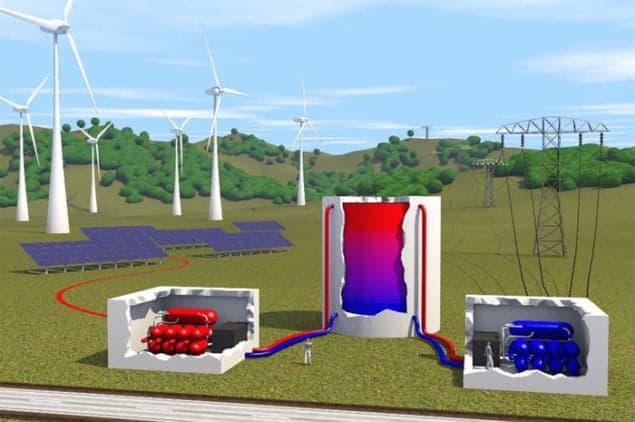
An idealized model for a system that would store large amounts of electrical energy by heating a tank of fluid has been developed by a physicist in Germany. The model is based on the concept of pumped heat electricity storage (PHES), which is a family of energy-storage technologies being developed worldwide to store electricity generated by intermittent sources such as wind turbines or solar panels. This latest research could help boost both the energy and cost efficiencies of these storage systems.
Large-scale stores
Renewable energy sources such as wind and solar do not produce energy at a constant rate and as a result engineers are developing large-scale energy-storage methods that can hold excess energy for use when the wind is not blowing or when the Sun is not shining. However, creating efficient storage systems is proving difficult as André Thess of the Ilmenau University of Technology points out in a recent paper in Physical Review Letters. Today, two techniques are used: pumped hydro storage (PHS) and compressed-air energy storage (CAES). Both, however, can be very difficult to implement. PHS needs kilometre-sized, elevated water reservoirs containing nearly 10 million cubic metres of water, while the CAES method involves finding or creating huge underground caverns.
PHES, on the other hand, is much simpler – electricity from a source such as a solar or wind farm is used to run a heat pump. The pump heats water stored in a large tank (normally about 100,000 cubic metres in volume) and then, when needed, the heated water is sent to a heat engine and electricity is produced. A heat pump, rather than an electric heater, is used to heat the water because it makes the whole process much more efficient. Heat pumps are designed to move thermal energy in the direction opposite to that of spontaneous heat flow and so use much less energy than would be needed to generate the heat with an electrical heater.
Optimized storage system
While this sounds great in theory, Thess points out that no large PHES system exists today and therefore the actual efficiency of such systems is still unknown. While other groups have proposed PHES systems that use everything from water, molten salt and liquid metals at various temperatures, predicting and comparing the performance of such systems has proved to be very difficult. The problem is that there are too many parameters involved; to overcome this, Thess has developed a simple thermodynamic model that can predict the efficiency of a PHES system as a function of the temperature of the thermal energy storage at maximum output power.
In his model, Thess assumes that the heat engine is optimized for maximum power – meaning that it produces electricity as quickly as it can – but not at maximum efficiency. By doing so, the efficiency of an entire cycle of storing and retrieving energy can be described by the ratio of the storage temperature to the ambient temperature of the surroundings.
So, for example, a PHES system that heats water at 20°C to 60°C would have an efficiency of about 38%. Thess says that the efficiency could be increased by increasing the storage temperature – which would involve using storage fluids other than water. However, he points out that water-based systems would be cheaper to build. With regard to established technologies, Thess’s analysis suggests that for storage temperatures above 400°C, PHES would be more efficient than CAES.
The research is published in Physical Review Letters.



